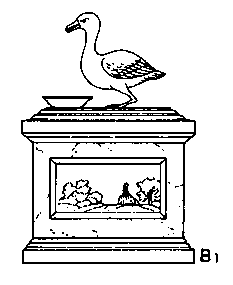> DeVaucanson's duck
The image of the duck as well as the following text on this page is from Sigvar Strandh: The history of the Machine (Dorset Press, New York, 1979).

Vaucanson's famous duck (above) had a weight-powered mechanism which consisted of over a thousand movable parts. These were hidden inside the duck and in the foundation upon which the bird stood. Unfortunately, the duck has now been lost. Some illustrations depicting it survive, however, among them this one (2 below), showing its innards.

A Zenith
The construction made by the highly talented French engineer Jacques de Vaucanson (1709-82) undoubtedly represent the zenith of the technical genre which produced automata. Even in his youth, in Grenoble, de Vaucanson had worked on various inventions and modifications for machines. In the mid-1730s, he decided to move to Paris and to involve himself with automata, which were all the rage at the time.He approached the subject systematically, beginning with a thorough study of anatomy, as he wanted to use mechanical aids to illustrate an anatomie mouvante ("moving anatomy"), which was to present human and animal organs in a three-dimensional atlas, no easy task! Here were Descartes's philosophical ideas, about to be turned into a technical reality at the hands of the clever de Vaucanson.
(SNIP - skipped segment about his life-size flute-playing shepherd).
In pursuit of his ideas about the "moving anatomy", de Vaucanson built yet another automaton, a mechanical duck which could move in the typical, wagging way of a duck, eat and digest fish, and excrete the remains in a "natural" way. The mechanism was driven by a weight and had more than a thousand moving parts, which were concealed, some inside the duck, and some in the base on which the bird stood. The feats performed by the duck were of a similar order to those performed by other automata of the time, but during the course of de Vaucanson's work, his genious for designing gave birth to new ideas, which represent important progress in the devlopment of technology. To produce his mechanisms, which demanded great exactitude, he designed among other things a precision lathe to cut threads. He was also the first to use a rubber hose. In his search for a suitable material for the duck's digestive canal, de Vaucanson came across the reports left by his compatriot Charles Marie de la Condamine about the remarkable material cautchouc, which he had discovered on the Amazon River during his expedition to South America in 1731. Vaucanson made hoses of this material and also invented a machine for that purpose.
De Vaucanson became a rich man from exhibiting his automata, and for several years, his mechanical duck was the most talked-about bird in Europe! He was also given public recognition for his work and was elected to the esteemed Academie des Sciences. But after touring for only a couple of years, he abandoned the building of automata, which was primarily a hobby, and became the director of the state-owned silk-mills. In his later years, he spent his time collecting interesting machines and pieces of apparatus. These eventually amounted to an impressive collection, which he bequeathed to the Conservatoire National des Arts et Metiers, then an insitute for technical education, and today a highly thought-of museum.
De Vaucanson's three automata met different fates. The flute- and tambourine-playing shepherd was destroyed in the revolution, while the others were bought by a German collector, Gottfried Christoph Beireis, a judge in Hemstedt. The social circle of this eccentric included Johann Wolfgang Goethe, who in his diary for 1805 described a meeting with de Vaucanson's automata. "They were in the most deplorable condition," the great poet wrote. "The duck was like a skeleton and had digestive problems..."